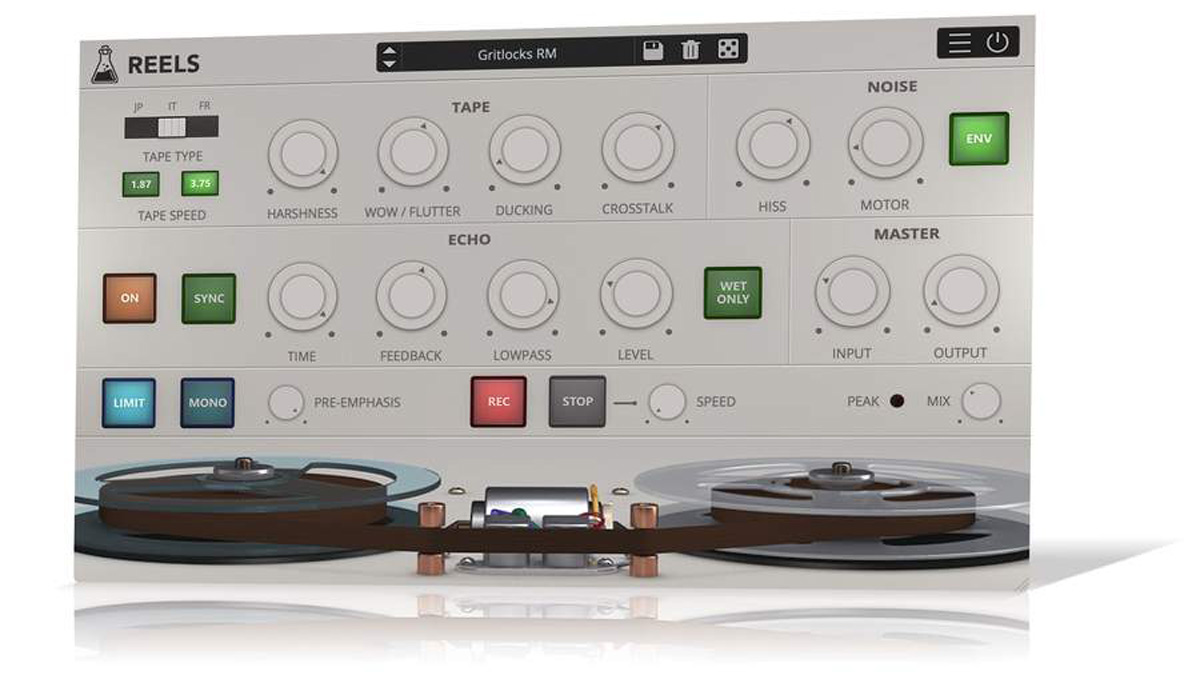MusicRadar Verdict
Creative noiseniks and retro-minded producers will get much more than their money’s worth from Reels’ evocatively crusty sonics and evil echoes.
Pros
- +
Supremely dirty tape emulation.
- +
Three tape styles and motor noise.
- +
Also a dub-tastic tape delay.
Cons
- -
At this price, nothing.
MusicRadar's got your back
The latest plugin effect from the ever-reliable AudioThing specifically models an old Japanese portable quarter-inch reel-to-reel tape recorder “found in a distressed state at a local flea market”.
Very much a consumer-level machine, one of its defining features is the bleeding of the motor noise into the tape, which limits the available bandwidth. Reels (VST/AU/ AAX), then, in short, isn’t your average tape sim looking to apply an aurally beneficial touch of analogue warmth to your pristine digital mixes: no, this is, instead, a gleefully grungy distortion and signal-mangling processor geared up to creatively tarnish whatever you choose to send its way.
Tape decked
At the top of the interface, the Tape and Noise sections are where the properties of the tape machine and the tape rolling through it are tweaked. First, you get three very different flavours of tape - Japanese, Italian and French - and a choice of 1.87 or 3.75ips playback speed. None of the tape nationalities are in any sense ‘clean’, but while Japanese and Italian maintain some semblance of bass, French rolls the low- end response off heavily for a fabulously biased sound. The 1.87ips setting, meanwhile, is noticeably lower-fi than 3.75ips, and between the six tape/speed combinations, a good range of base colours is represented.
The Harshness, Wow/Flutter, Ducking and Crosstalk knobs enable detailed tailoring of the tape and deck characteristics. Harshness describes the physical condition of the tape, delivering heavy distortion/breakup at 100%; and Wow/Flutter introduces unpredictable pitch modulation that varies with tape speed. Ducking and Crosstalk govern the amount of random volume drop-outs in the tape, and leakage between left and right channels, respectively.
The Hiss and Motor controls set the amount of signal generated by the tape itself and the internal machinery of the deck. Hiss is synthesised for each tape type, while Motor is a sampled loop, layered with custom elements for constant variation. Each has its own level knob, and engaging the Env button silences both when no input signal is present.
As well as its main function as a colouration/distortion processor, Reels’ tape emulation can also be deployed as a delay effect.
The delay Time knob ranges from 1-1000ms unsynced or 1/16 to 2/1 synced, and, this being a tape delay, changing the Time slows down and speeds up the passage of the tape, generating all sorts of crazy pitchshifting effects. The Feedback knob routes the output back to the input to extend the repeats (infinitely when cranked up - hence the limiter), and a low-pass filter is on hand for darkening the tone, with a cutoff frequency range of 200Hz to 16kHz. Activating the Wet Only button kills the dry signal for using Reels as an auxiliary effect.
As any good tape delay should, Reels excels at classic dub-style feedback washes. Catch those pitch-shifting Time changes in the feedback loop and get to work with the Lowpass filter and it’s as if Lee ‘Scratch’ Perry is in the room with you. Glorious.
At the bottom, Limit switches in a soft clipper, and Mono sums the stereo output. The Pre-Emphasis dial applies up to 12dB of high- frequency boost prior to the tape emulation, countering the loss in top-end that inevitably comes with it. Last but not least, the linked Rec/ Stop buttons (activating one deactivates the other) start and stop playback, muting the output of the plugin when stopped. The time it takes for the tape to come to a halt is determined by the Speed knob (up to five seconds), and the resulting down-pitching tape stop effect is thoroughly convincing.
Last but not least, the dry/wet Mix control proves crucial for getting Reels working well in a broader musical context than simply making the source material appear to be coming from a knackered old tape deck.
The Reels thing
With its uniquely messed-up approach and authentic ‘crap tape’ sound, Reels is another winner for AudioThing, and a plugin that no producer of lo-fi, synthwave or any other retro-inspired style should miss. If you’re hoping to make your mixes sound like they’ve been mastered to expensive tape on a fancy precision deck, however, run screaming...
Computer Music magazine is the world’s best selling publication dedicated solely to making great music with your Mac or PC computer. Each issue it brings its lucky readers the best in cutting-edge tutorials, need-to-know, expert software reviews and even all the tools you actually need to make great music today, courtesy of our legendary CM Plugin Suite.
“For some reason, the post office shipped your guitar to Jim Root of Slipknot”: Sweetwater mailed a metal fan's Jackson guitar to a metal legend
"No one phoned me. They never contacted me and I thought, 'Well, I'm not going to bother contacting them either'": Ex-Judas Priest drummer Les Binks has died aged 73
With the same mesh-head playability and powerful new Strata module as its bigger brothers, Alesis Strata Club brings a new compact form to its best-selling range











